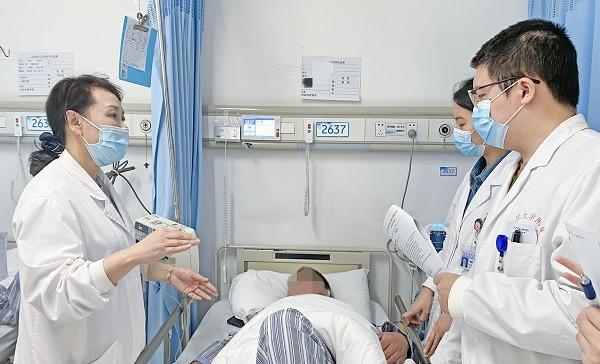
Pictured: Zhao Jing (left) inspecting the room Courtesy of the interviewee
Recently, in order to further focus on the problem of stroke, the World Stroke Organization (WSO) announced the establishment of a new branch: the Pre-hospital Medical Working Group, and appointed Professor Zhao Jing of Fudan University and Professor Renyu Liu of the University of Pennsylvania as the co-chair of the organization's pre-hospital medical working group. The working group is composed of experts from 7 countries around the world engaged in the field of stroke prevention and control, and Professor Li Dou, director of the Beijing Emergency Center and chairman of the Emergency Branch of the Chinese Stroke Society, is also one of the standing committee members of the working group.
This marks that in recent years, China's experts have paid attention to stroke pre-hospital medical treatment, China Stroke 120 Special Action and International Stroke Identification Tool (Stroke 112) has been effective, has been highly recognized internationally, and the contributions of Chinese scholars in the field of stroke in the world have attracted more and more attention from the world, and also mark that relevant experts around the world attach great importance to pre-stroke treatment and related issues. It is urgent to solve the delay before the stroke hospital.
Zhao Jing will work with nine experts in the field of stroke prevention and control from 7 countries around the world to focus on key issues related to pre-hospital medical treatment of stroke and reduce the burden of stroke worldwide.
According to the reporter's understanding, the World Stroke Organization is the only global organization that specializes in stroke, and its mission is to reduce the burden of stroke around the world by solving problems related to pre-hospital medical treatment of stroke. This includes raising awareness of first aid and prevention of stroke, optimizing pre-hospital care processes, advocating for national and local policy improvements, improving the transition from pre-hospital to inpatient care, and working to improve the quality of pre-hospital care for stroke.
Zhao Jing said in an interview with reporters that stroke is a disease with extremely high morbidity, disability rate and mortality in China, but through drug thrombolysis and catheter thrombolysis treatment, most patients can stand up again and act as usual. Unfortunately, many patients do not understand stroke, thinking that a rest will be better, missed the best treatment time of 4.5 hours, thus leaving a lifetime regret of disability.
It is reported that "Stroke 120" was specially designed by Professor Zhao Jing of Fudan University and Professor Liu Renyu of the University of Pennsylvania specifically for this problem, and published in Lancet Neurology. "1 look - 1 face is asymmetrical, the corners of the mouth are crooked. 2 check - two arms, unilateral weakness, can not be lifted. 0 (listening) Listening – speaking slurred and unclear", if any of the above symptoms suddenly occur, immediately call the emergency number 120. Such a grounded identification method is simple and easy to understand, suitable for all ages. In recent years, after continuous publicity, the concept of "Stroke 120" has been deeply rooted in the hearts of the people in China, with remarkable results, and has aroused great attention and praise from the international medical community.
It is understood that although the "Stroke 120" method is simple, it is not an easy task to become known to everyone. From micro-videos to micro-movies, from popular science comics to stroke 120 songs to fire dance performances, as long as you can think of popular science, Zhao Jing is willing to try, and even personally appear on camera and personally dubbed, just to let more people master the stroke recognition method.
Micro-video is the most widely used of these popular science methods, has launched more than 30 dialect versions, and recently the Tibetan version and Uyghur language version have also been produced and will be launched soon.
After several years of popular science publicity, the effect is gradually reflected. The Central Hospital of Minhang District, where Zhao Jing is located, as a pilot, has led to a sharp decline in pre-hospital delays in Minhang, with the arrival rate within 3 hours rising from the original 26.9% to 34.7%, and the thrombolysis rate reaching 9%, far higher than the national average of 2.6%. At present, this model is being promoted nationwide.
Correspondent Sun Guogen Xinmin Evening News reporter Zuo Yan